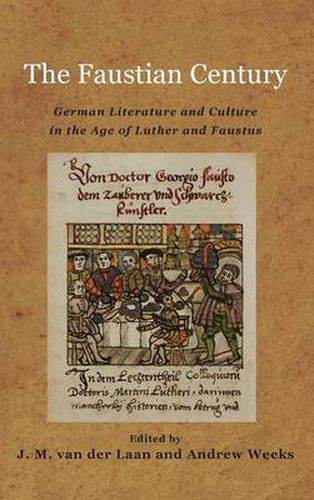Readings Newsletter
Become a Readings Member to make your shopping experience even easier.
Sign in or sign up for free!
You’re not far away from qualifying for FREE standard shipping within Australia
You’ve qualified for FREE standard shipping within Australia
The cart is loading…






The Reformation and Renaissance, though segregated into distinct disciplines today, interacted and clashed intimately in Faust, the great figure that attained European prominence in the anonymous 1587 Historia von D. Johann Fausten. The original Faust behind Goethe’s great drama embodies a remote culture. In his century, Faust evolved from an obscure cipher to a universal symbol. The age explored here as the Faustian century invested the Faustbuch and its theme with a symbolic significance still of exceptional relevance today.
The new essays in this volume complement one another, providing insights into the tensions and forces that gave the century its distinctcharacter. Several essays seek Faust’s prototypes. Others elaborate the symbolic function of his figure and discern the resonance of his tale in conflicting allegiances. This volume focuses on the intersection of historical accounts and literary imaginings, on shared aspects of the work and its times, on concerns with obedience and transgression, obsessions with the devil and curiosity about magic, and quandaries created by shifting religious and worldlyauthorities.
Contributors: Marguerite de Huszar Allen, Kresten Thue Andersen, Frank Baron, Gunther Bonheim, Albrecht Classen, Urs Leo Gantenbein, Karl S. Guthke, Michael Keefer, Paul Ernst Meyer, J. M. van der Laan, Helen Watanabe-O'Kelly, Andrew Weeks.
J. M. van der Laan is Professor of German and Andrew Weeks is Professor of German and Comparative Literature, both at Illinois State University.
$9.00 standard shipping within Australia
FREE standard shipping within Australia for orders over $100.00
Express & International shipping calculated at checkout
The Reformation and Renaissance, though segregated into distinct disciplines today, interacted and clashed intimately in Faust, the great figure that attained European prominence in the anonymous 1587 Historia von D. Johann Fausten. The original Faust behind Goethe’s great drama embodies a remote culture. In his century, Faust evolved from an obscure cipher to a universal symbol. The age explored here as the Faustian century invested the Faustbuch and its theme with a symbolic significance still of exceptional relevance today.
The new essays in this volume complement one another, providing insights into the tensions and forces that gave the century its distinctcharacter. Several essays seek Faust’s prototypes. Others elaborate the symbolic function of his figure and discern the resonance of his tale in conflicting allegiances. This volume focuses on the intersection of historical accounts and literary imaginings, on shared aspects of the work and its times, on concerns with obedience and transgression, obsessions with the devil and curiosity about magic, and quandaries created by shifting religious and worldlyauthorities.
Contributors: Marguerite de Huszar Allen, Kresten Thue Andersen, Frank Baron, Gunther Bonheim, Albrecht Classen, Urs Leo Gantenbein, Karl S. Guthke, Michael Keefer, Paul Ernst Meyer, J. M. van der Laan, Helen Watanabe-O'Kelly, Andrew Weeks.
J. M. van der Laan is Professor of German and Andrew Weeks is Professor of German and Comparative Literature, both at Illinois State University.